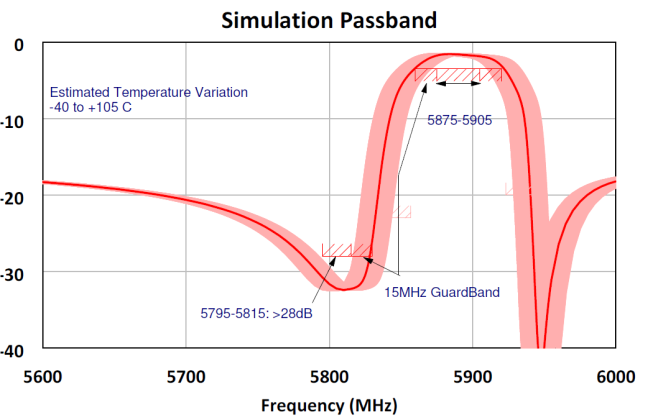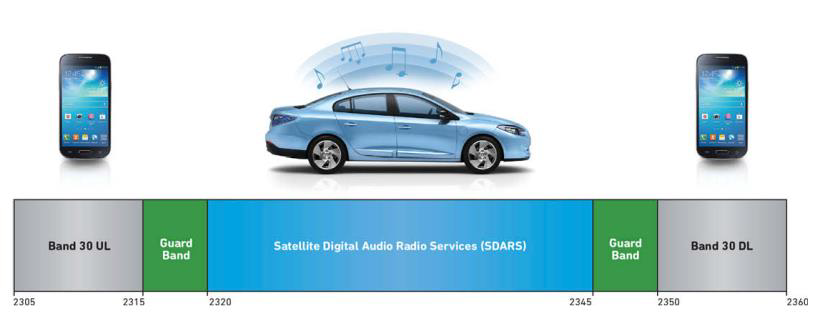Automobiles are relying on a growing number of wireless technologies as the connected car becomes a reality. Many vehicles already support LTE data connections and operate as small WiFi hotspots. Vehicle-to-vehicle (V2V) and vehicle-to-infrastructure (V2X) communications are expected to become a reality over the next few years, using the IEEE 802.11p standard over the 5.9 GHz Dedicated Short Range Communications (DSRC) band.
The DSRC band is a gateway to better collision-avoidance and other intelligent transportation applications, but creates formidable RF challenges. As this connected-car trend unfolds, vehicles are increasingly using higher-frequency RF bands that are very close to those used for other purposes, and interference between these bands has become a key concern. In many cases, there’s almost no separation between bands, which makes meeting regulatory requirements for reducing out-of-band emissions extremely difficult.
Avoiding interference in these cases requires high-performance RF bandpass filters capable of operating at high frequencies. These filters must provide steep skirts to prevent signals from bleeding into adjacent bands, and low insertion loss across the passband to sustain output power and maximize range. Filters used in automotive applications also must be able to operate under challenging physical conditions, operating reliably over the expected life of the vehicle while subjected to the extremes of temperature and humidity. DSRC, in particular, also presents the challenge of delivering this performance at frequencies much higher than traditional cellular bands.
With their precise selectivity and small size, BAW filters are suitable for advanced RF applications in vehicles, and can operate reliably over the expected life of the vehicle while subjected to hash conditions. We will explore some of these automotive applications here.
802.11p and European Toll Systems
IEEE defines 802.11p as an approved amendment to the IEEE 802.11 standard to add wireless access in vehicular environments (WAVE). For 802.11p systems operating in the 5.9 GHz DSRC band, a key issue is coexistence with electronic toll systems in Europe.
In many European countries, toll systems operate in the 5795-5815 GHz band, and European Telecommunications Standards Institute (ETSI) has placed tight requirements on out-of-band emissions. At 5.9 GHz, losses in all parts of the transmission chain will be high, and the link budget will depend on the ability of the filter to prevent interference with other systems.
To date, there hasn’t been a workable, affordable solution that enables 802.11p systems to meet the ETSI requirements. As shown in Figure 1, solutions must provide low insertion loss across the DSRC band along with very steep skirts to avoid interference with the spectrum used by toll systems, which is separated by a guard band of only 15 MHz.
Simulations based on measured test structures confirm that BAW filters can exceed these requirements, but temperature adds another concern.

Automotive filters must meet ETSI requirements across a broad temperature range. Temperature drift—the shift in filter frequency response as the temperature changes—has become a major obstacle when trying to avoid interference between closely spaced bands. Automotive applications operate at a temperature range from -40 to +105 degrees Celsius, and vehicles are driven in conditions ranging from extreme summer heat to snow and ice. Filters are often in locations subjected to even greater temperature variation and heat stress, such as rooftop aerials or engine compartments.
BAW filters are inherently less sensitive to temperature change than other acoustic filters, but traditional BAW manufacturing processes are not enough to meet the stringent requirements for DSRC systems in Europe. Solving the problem requires advanced processes that create temperature-compensated BAW filters with a much more stable response to temperature variation.
Satellite Radio and the WCS Band
Satellite radio is another case where temperature-compensated BAW filters are needed. The satellite digital radio audio service (SDARS) band is sandwiched between the uplink and downlink bands of FDD-LTE Band 30, which operates in the Wireless Communications Service (WCS) spectrum (Figure 2). Only a 5 MHz guard band exists on each side of the SDARS spectrum. To enable satellite radio services to operate while protecting the adjacent WCS band from interference, a fully temperature-compensated BAW filter with near-zero TCF is needed. The filter is embedded in the vehicle’s antenna.

WiFi/LTE Coexistence
Connected cars not only face coexistence challenges from outside the vehicle, but from inside as well. WiFi and LTE communications often must operate simultaneously in vehicles without interference. As consumers, this allows us to connect with our car’s WiFi hotspot, while simultaneously using cellular technologies on our mobile devices.
The biggest challenges are coexistence between 2.4 GHz WiFi and LTE Bands 40 and 41. Band 40 is a TDD-LTE band used in China. Band 41 is used both in China and the United States. Band 7, predominantly used in Europe, is also close to the WiFi spectrum. There’s only a miniscule 1 MHz guard band between LTE Band 40 and WiFi channel 1, and the same gap between WiFi channel 14 and LTE Band 41. Temperature-stable BAW filters enable coexistence between WiFi and both bands with minimal need to sacrifice bandwidth.
Reliability
Automobiles have a much longer working life than smartphones and other devices. To ensure reliability over the life of the vehicle, automotive filters should be tested and audited to a much greater extent than for other commercial applications. The Automotive Electronics Council AEC-Q200 quality standard for passive components (such as filters) includes stringent stress tests for stability under high temperatures and temperature changes; resistance to humidity; and mechanical stresses such as shock, vibration, and board flex.
While BAW filters are used extensively in smartphones and other mobile devices, their precise selectivity, size, performance, and low insertion loss are ideal for advanced RF applications. BAW filters uniquely offer all the capabilities required for the 5.9 GHz band. In particular, reliable, temperature-compensated BAW will become increasingly important, as the connected car becomes reality.

